英语有关方位常用的句子
- 格式:doc
- 大小:41.50 KB
- 文档页数:6
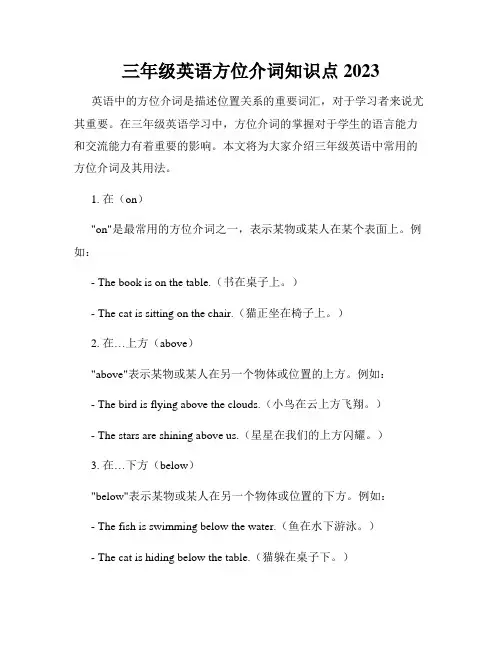
三年级英语方位介词知识点2023英语中的方位介词是描述位置关系的重要词汇,对于学习者来说尤其重要。
在三年级英语学习中,方位介词的掌握对于学生的语言能力和交流能力有着重要的影响。
本文将为大家介绍三年级英语中常用的方位介词及其用法。
1. 在(on)"on"是最常用的方位介词之一,表示某物或某人在某个表面上。
例如:- The book is on the table.(书在桌子上。
)- The cat is sitting on the chair.(猫正坐在椅子上。
)2. 在…上方(above)"above"表示某物或某人在另一个物体或位置的上方。
例如:- The bird is flying above the clouds.(小鸟在云上方飞翔。
)- The stars are shining above us.(星星在我们的上方闪耀。
)3. 在…下方(below)"below"表示某物或某人在另一个物体或位置的下方。
例如:- The fish is swimming below the water.(鱼在水下游泳。
)- The cat is hiding below the table.(猫躲在桌子下。
)4. 在…之间(between)"between"表示两个物体或位置之间的关系。
例如:- The bookshelf is between the window and the door.(书架在窗户和门之间。
)- The park is between the school and the hospital.(公园位于学校和医院之间。
)5. 在…旁边(beside)"beside"表示某物或某人在另一个物体或位置的旁边。
例如:- The tree is beside the river.(树在河边。
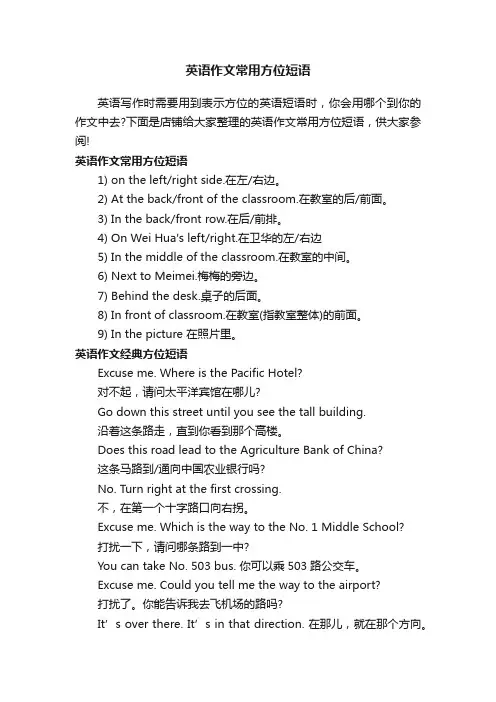
英语作文常用方位短语英语写作时需要用到表示方位的英语短语时,你会用哪个到你的作文中去?下面是店铺给大家整理的英语作文常用方位短语,供大家参阅!英语作文常用方位短语1) on the left/right side.在左/右边。
2) At the back/front of the classroom.在教室的后/前面。
3) In the back/front row.在后/前排。
4) On Wei Hua's left/right.在卫华的左/右边5) In the middle of the classroom.在教室的中间。
6) Next to Meimei.梅梅的旁边。
7) Behind the desk.桌子的后面。
8) In front of classroom.在教室(指教室整体)的前面。
9) In the picture 在照片里。
英语作文经典方位短语Excuse me. Where is the Pacific Hotel?对不起,请问太平洋宾馆在哪儿?Go down this street until you see the tall building.沿着这条路走,直到你看到那个高楼。
Does this road lead to the Agriculture Bank of China?这条马路到/通向中国农业银行吗?No. Turn right at the first crossing.不,在第一个十字路口向右拐。
Excuse me. Which is the way to the No. 1 Middle School?打扰一下,请问哪条路到一中?You can take No. 503 bus. 你可以乘503路公交车。
Excuse me. Could you tell me the way to the airport?打扰了。
你能告诉我去飞机场的路吗?It’s over there. It’s in that direction. 在那儿,就在那个方向。
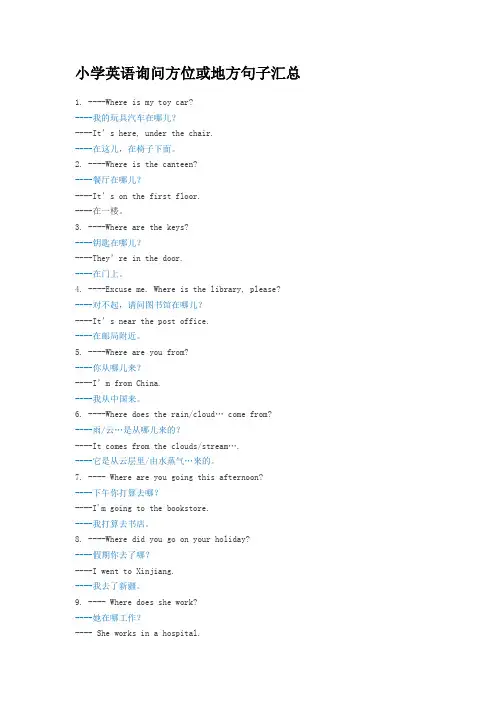
小学英语询问方位或地方句子汇总1. ----Where is my toy car?----我的玩具汽车在哪儿?----It’s here, under the chair.----在这儿,在椅子下面。
2. ----Where is the canteen?----餐厅在哪儿?----It’s on the first floor.----在一楼。
3. ----Where are the keys?----钥匙在哪儿?----They’re in the door.----在门上。
4. ----Excuse me. Where is the library, please?----对不起,请问图书馆在哪儿?----It’s near the post office.----在邮局附近。
5. ----Where are you from?----你从哪儿来?----I’m from China.----我从中国来。
6. ----Where does the rain/cloud… come from?----雨/云…是从哪儿来的?----It comes from the clouds/stream….----它是从云层里/由水蒸气…来的。
7. ---- Where are you going this afternoon?----下午你打算去哪?----I'm going to the bookstore.----我打算去书店。
8. ----Where did you go on your holiday?----假期你去了哪?----I went to Xinjiang.----我去了新疆。
9. ---- Where does she work?----她在哪工作?---- She works in a hospital.----她在医院工作。
10. ----Where is the cinema, please?----请问电影院在哪?----It's next to the hospital.----在医院旁边。
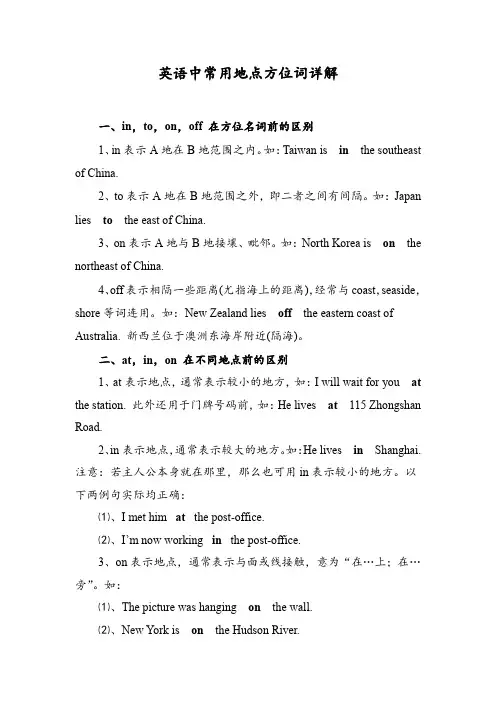
英语中常用地点方位词详解一、in,to,on,off 在方位名词前的区别1、in表示A地在B地范围之内。
如:Taiwan is in the southeast of China.2、to表示A地在B地范围之外,即二者之间有间隔。
如:Japan lies to the east of China.3、on表示A地与B地接壤、毗邻。
如:North Korea is on the northeast of China.4、off表示相隔一些距离(尤指海上的距离),经常与coast,seaside,shore等词连用。
如:New Zealand lies off the eastern coast of Australia. 新西兰位于澳洲东海岸附近(隔海)。
二、at,in,on 在不同地点前的区别1、at表示地点,通常表示较小的地方,如:I will wait for you at the station. 此外还用于门牌号码前,如:He lives at115 Zhongshan Road.2、in表示地点,通常表示较大的地方。
如:He lives in Shanghai. 注意:若主人公本身就在那里,那么也可用in表示较小的地方。
以下两例句实际均正确:⑴、I met him at the post-office.⑵、I’m now working in the post-office.3、on表示地点,通常表示与面或线接触,意为“在…上;在…旁”。
如:⑴、The picture was hanging on the wall.⑵、New York is on the Hudson River.三、near,by,beside,at 表示“在…附近”的区别1、near表示相对的近,实际距离有可能很远。
如:Suzhou is near Shanghai.2、by和beside都表示靠近,实际距离不远,但beside比by更具体地表示出“在…旁边”的意思。
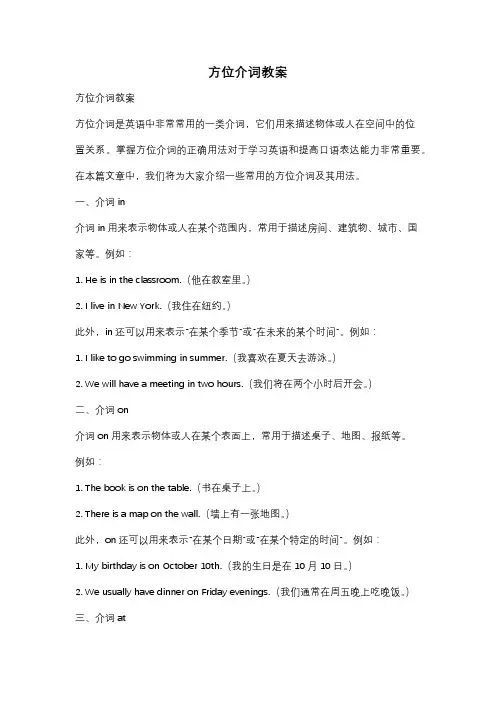
方位介词教案方位介词教案方位介词是英语中非常常用的一类介词,它们用来描述物体或人在空间中的位置关系。
掌握方位介词的正确用法对于学习英语和提高口语表达能力非常重要。
在本篇文章中,我们将为大家介绍一些常用的方位介词及其用法。
一、介词in介词in用来表示物体或人在某个范围内,常用于描述房间、建筑物、城市、国家等。
例如:1. He is in the classroom.(他在教室里。
)2. I live in New York.(我住在纽约。
)此外,in还可以用来表示“在某个季节”或“在未来的某个时间”。
例如:1. I like to go swimming in summer.(我喜欢在夏天去游泳。
)2. We will have a meeting in two hours.(我们将在两个小时后开会。
)二、介词on介词on用来表示物体或人在某个表面上,常用于描述桌子、地图、报纸等。
例如:1. The book is on the table.(书在桌子上。
)2. There is a map on the wall.(墙上有一张地图。
)此外,on还可以用来表示“在某个日期”或“在某个特定的时间”。
例如:1. My birthday is on October 10th.(我的生日是在10月10日。
)2. We usually have dinner on Friday evenings.(我们通常在周五晚上吃晚饭。
)三、介词at介词at用来表示物体或人在某个具体的位置或地点,常用于描述街道、广场、机场等。
例如:1. They are waiting for the bus at the bus stop.(他们在公交车站等车。
)2. I will meet you at the coffee shop.(我会在咖啡店见你。
)此外,at还可以用来表示“在某个具体的时间点”。
例如:1. The meeting will start at 9 o'clock.(会议将在9点开始。
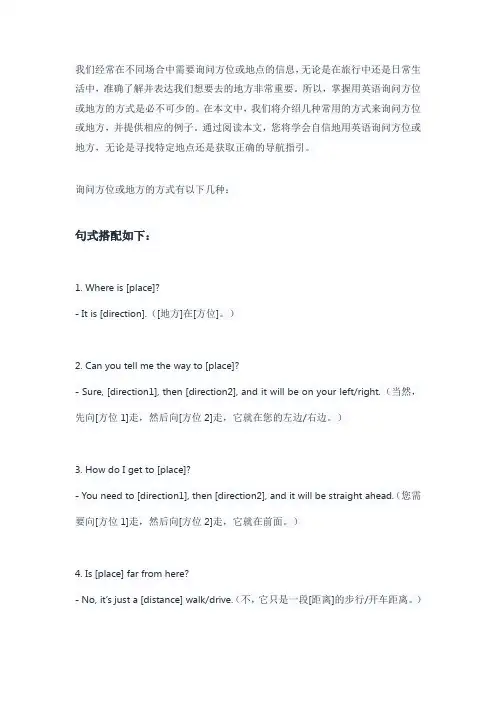
我们经常在不同场合中需要询问方位或地点的信息,无论是在旅行中还是日常生活中,准确了解并表达我们想要去的地方非常重要。
所以,掌握用英语询问方位或地方的方式是必不可少的。
在本文中,我们将介绍几种常用的方式来询问方位或地方,并提供相应的例子。
通过阅读本文,您将学会自信地用英语询问方位或地方,无论是寻找特定地点还是获取正确的导航指引。
询问方位或地方的方式有以下几种:句式搭配如下:1. Where is [place]?- It is [direction].([地方]在[方位]。
)2. Can you tell me the way to [place]?- Sure, [direction1], then [direction2], and it will be on your left/right.(当然,先向[方位1]走,然后向[方位2]走,它就在您的左边/右边。
)3. How do I get to [place]?- You need to [direction1], then [direction2], and it will be straight ahead.(您需要向[方位1]走,然后向[方位2]走,它就在前面。
)4. Is [place] far from here?- No, it’s just a [distance] walk/drive.(不,它只是一段[距离]的步行/开车距离。
)以下是具体例子:1. Where is the nearest train station?- It is south of here.(最近的火车站在这里的南方。
)2. Can you tell me the way to the grocery store?- Sure, go east on this street, then turn left at the intersection, and it will be on your right.(当然,沿着这条街道向东走,然后在路口向左转,它就在您的右边。
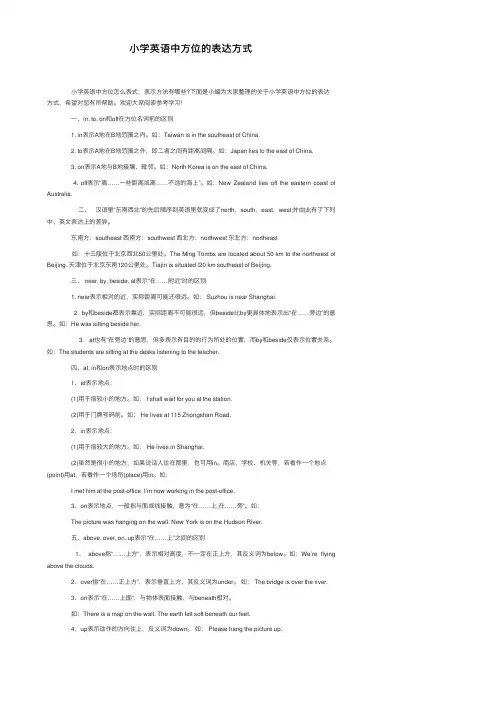
⼩学英语中⽅位的表达⽅式 ⼩学英语中⽅位怎么表式,表⽰⽅法有哪些?下⾯是⼩编为⼤家整理的关于⼩学英语中⽅位的表达⽅式,希望对您有所帮助。
欢迎⼤家阅读参考学习! ⼀、in, to, on和off在⽅位名词前的区别 1. in表⽰A地在B地范围之内。
如:Taiwan is in the southeast of China. 2. to表⽰A地在B地范围之外,即⼆者之间有距离间隔。
如:Japan lies to the east of China. 3. on表⽰A地与B地接壤、毗邻。
如:North Korea is on the east of China. 4. off表⽰“离……⼀些距离或离……不远的海上”。
如:New Zealand lies off the eastern coast of Australia. ⼆、汉语⾥“东南西北”的先后顺序到英语⾥就变成了north,south,east,west;并由此有了下列中、英⽂表达上的差异。
东南⽅:southeast 西南⽅:southwest 西北⽅:northwest 东北⽅:northeast 如:⼗三陵位于北京西北50公⾥处。
The Ming Tombs are located about 50 km to the northwest of Beijing. 天津位于北京东南120公⾥处。
Tiajin is situated l20 km southeast of Beijing. 三、 near, by, beside, at表⽰“在……附近”时的区别 1. near表⽰相对的近,实际距离可能还很远。
如: Suzhou is near Shanghai. 2. by和beside都表⽰靠近,实际距离不可能很远,但beside⽐by更具体地表⽰出“在……旁边”的意思。
如:He was sitting beside her. 3. at也有“在旁边”的意思,但多表⽰有⽬的的⾏为所处的位置,⽽by和beside仅表⽰位置关系。
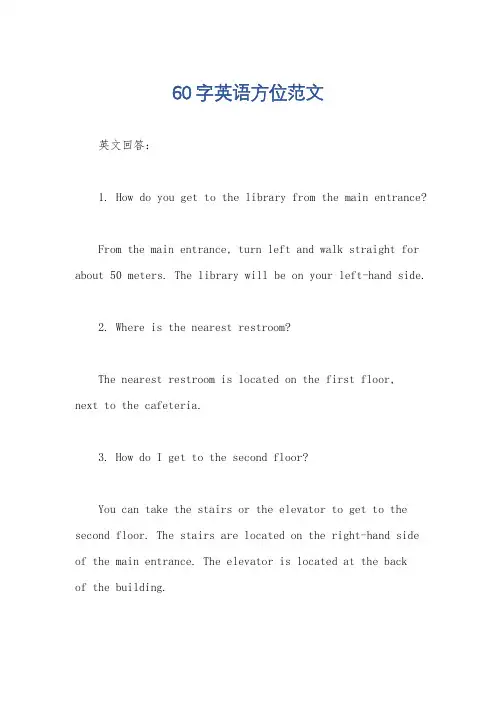
60字英语方位范文英文回答:1. How do you get to the library from the main entrance?From the main entrance, turn left and walk straight for about 50 meters. The library will be on your left-hand side.2. Where is the nearest restroom?The nearest restroom is located on the first floor,next to the cafeteria.3. How do I get to the second floor?You can take the stairs or the elevator to get to the second floor. The stairs are located on the right-hand side of the main entrance. The elevator is located at the backof the building.4. Where is the parking lot?The parking lot is located behind the building. You can access it by turning right at the main entrance and driving straight for about 100 meters.5. How do I get to the computer lab?The computer lab is located on the second floor, next to the library.中文回答:1. 怎样从正门去图书馆?从正门左转,直走约50米。
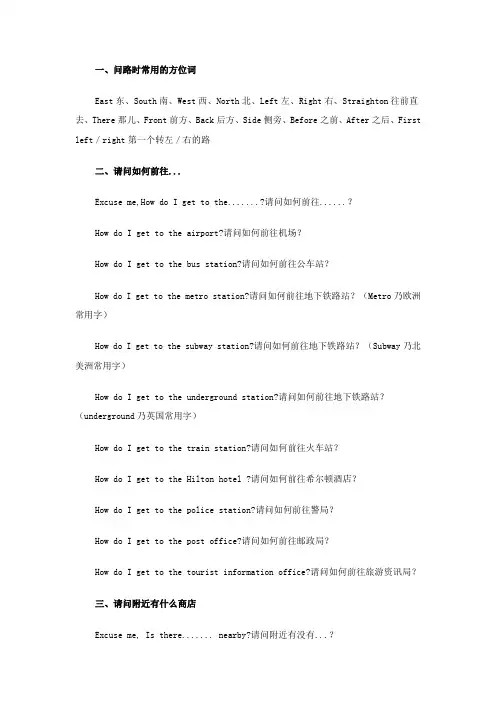
一、问路时常用的方位词East东、South南、West西、North北、Left左、Right右、Straighton往前直去、There那儿、Front前方、Back后方、Side侧旁、Before之前、After之后、First left/right第一个转左/右的路二、请问如何前往...Excuse me,How do I get to the.......?请问如何前往......?How do I get to the airport?请问如何前往机场?How do I get to the bus station?请问如何前往公车站?How do I get to the metro station?请问如何前往地下铁路站?(Metro乃欧洲常用字)How do I get to the subway station?请问如何前往地下铁路站?(Subway乃北美洲常用字)How do I get to the underground station?请问如何前往地下铁路站?(underground乃英国常用字)How do I get to the train station?请问如何前往火车站?How do I get to the Hilton hotel ?请问如何前往希尔顿酒店?How do I get to the police station?请问如何前往警局?How do I get to the post office?请问如何前往邮政局?How do I get to the tourist information office?请问如何前往旅游资讯局?三、请问附近有什么商店Excuse me, Is there....... nearby?请问附近有没有...?Is there a disco nearby?请问附近有没有的士高?Is there a hospital nearby? 请问附近有没有医院?Is there a night club nearby?请问附近有没有夜总会?Is there a post box nearby?请问附近有没有邮政局?Is there a public toilet nearby?请问附近有没有公共厕所?Is there a restaurant nearby?请问附近有没有餐厅?Is there a telephone nearby?请问附近有没有电话?Is there a travel agent nearby?请问附近有没有旅游社?Is there a youth hostel nearby?请问附近有没有青年旅馆?Is there a baker nearby? 请问附近有没有面包店?Is there a bank nearby? 请问附近有没有银行?Is there a bar nearby? 请问附近有没有酒吧?Is there a bus stop nearby? 请问附近有没有公车站?Is there a cafe nearby? 请问附近有没有咖啡店?Is there a cake shop nearby? 请问附近有没有西饼店?Is there a change bureau nearby? 请问附近有没有找换店?Is there a chemist"s nearby?请问附近有没有药剂师?Is there a department store nearby?请问附近有没有百货公司?。
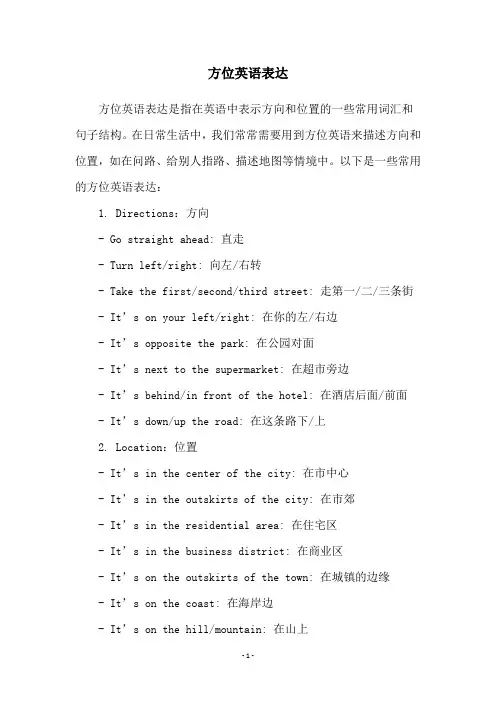
方位英语表达方位英语表达是指在英语中表示方向和位置的一些常用词汇和句子结构。
在日常生活中,我们常常需要用到方位英语来描述方向和位置,如在问路、给别人指路、描述地图等情境中。
以下是一些常用的方位英语表达:1. Directions:方向- Go straight ahead: 直走- Turn left/right: 向左/右转- Take the first/second/third street: 走第一/二/三条街 - It’s on your left/right: 在你的左/右边- It’s opposite the park: 在公园对面- It’s next to the supermarket: 在超市旁边- It’s behind/in front of the hotel: 在酒店后面/前面- It’s down/up the road: 在这条路下/上2. Location:位置- It’s in the center of the city: 在市中心- It’s in the outskirts of the city: 在市郊- It’s in the residential area: 在住宅区- It’s in the business district: 在商业区- It’s on the outskirts of the town: 在城镇的边缘- It’s on the coast: 在海岸边- It’s on the hill/mountain: 在山上- It’s in the valley: 在山谷里3. Prepositions:介词- In front of: 在前面- Behind: 在后面- On: 在上面- Under: 在下面- Next to: 在旁边- Between: 在两者之间- Across from: 在对面- Along: 沿着以上是一些常用的方位英语表达,掌握这些基础的词汇和句子结构,能够帮助我们更好地进行英语交流和应对日常生活中的方向和位置问题。
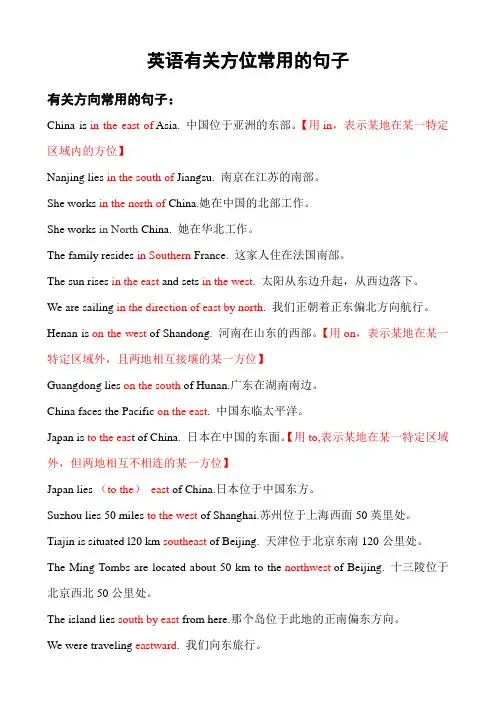
英语有关方位常用的句子有关方向常用的句子:China is in the east of Asia. 中国位于亚洲的东部。
【用in,表示某地在某一特定区域内的方位】Nanjing lies in the south of Jiangsu. 南京在江苏的南部。
She works in the north of China.她在中国的北部工作。
She works in North China. 她在华北工作。
The family resides in Southern France. 这家人住在法国南部。
The sun rises in the east and sets in the west. 太阳从东边升起,从西边落下。
We are sailing in the direction of east by north. 我们正朝着正东偏北方向航行。
Henan is on the west of Shandong. 河南在山东的西部。
【用on,表示某地在某一特定区域外,且两地相互接壤的某一方位】Guangdong lies on the south of Hunan.广东在湖南南边。
China faces the Pacific on the east. 中国东临太平洋。
Japan is to the eas t of China. 日本在中国的东面。
【用to,表示某地在某一特定区域外,但两地相互不相连的某一方位】Japan lies (to the)east of China.日本位于中国东方。
Suzhou lies 50 miles to the west of Shanghai.苏州位于上海西面50英里处。
Tiajin is situated l20 km southeast of Beijing. 天津位于北京东南120公里处。
The Ming Tombs are located about 50 km to the northwest of Beijing. 十三陵位于北京西北50公里处。
和方位有关的英语俚语Directional Slang in English: A Linguistic Journey through the Landscape of Place.English, a language rich in vocabulary and expression,is also home to a vast array of slang and colloquialismsthat reflect the unique culture and experiences of its speakers. When it comes to slang related to directions and spatial relations, the language offers a fascinatingglimpse into the way people navigate their world and communicate their spatial understanding.1. Over the Moon: This expression, which means "extremely happy or pleased,"originates from the idea of looking up and beyond, towards the moon, which was once considered a symbol of unreachable perfection.2. Under the Weather: To say someone is "under the weather" is to indicate that they are feeling ill or unwell. This slang is thought to have originated from the days whenbad weather was a common cause of sickness.3. Up in the Air: When something is "up in the air," it means it is undecided or uncertain. This expression evokes images of something floating, unsettled, or uncommitted.4. On the Fence: To be "on the fence" about something is to be indecisive or hesitant about taking a side or making a decision. This slang is similar to "sitting on the fence," which suggests a lack of commitment or neutrality.5. In the Dark: To be "in the dark" about something is to lack knowledge or understanding. This expression alludes to the idea of being literally in a dark place, where visibility is limited, symbolizing a lack of clarity or information.6. On the Right Track: To be "on the right track" is to be heading in the correct direction or making progress towards a goal. This slang suggests that one is following a path that will lead to success or satisfaction.7. Off the Beaten Path: Something that is "off the beaten path" is unusual, unconventional, or not widely known. This expression conjures images of traveling through uncharted territory, exploring beyond the familiar and comfortable.8. On the Map: When something or someone is "on the map," it means they have achieved recognition or prominence. This slang is reminiscent of marking a location on a map, indicating a point of significance or interest.9. Head Over Heels: To be "head over heels" is to be completely and hopelessly in love. This expression is thought to have originated from the image of someonefalling backwards, head over heels, symbolizing the overwhelming passion and excitement of new love.10. On Cloud Nine: To be "on cloud nine" is to be extremely happy or satisfied, usually after achieving something significant. This slang is a reference to the highest cloud in the sky, symbolizing a state of euphoriaor elation.These are just a few examples of the rich and diverse slang expressions related to directions and spatial relations in English. They offer a window into the culture, traditions, and experiences of English speakers and highlight the creative and expressive nature of the language. From "over the moon" to "on cloud nine," these slang terms evoke powerful emotional and contextual resonances that enrich our understanding of the English language and its users.。
和方位有关的英语Sure, let's talk about the topic related to directionsin English.In English, we use different words and phrases to indicate directions and locations. For example, "north" means the direction towards the North Pole, "east" is the direction of the sunrise, "south" is the opposite of north, and "west" is where the sun sets. We also use words like "left" and "right" to describe directions, as well as phrases like "in front of," "behind," "next to," and "opposite" to indicate relative positions. Additionally, we use compass directions such as "northwest," "southeast," and so on to be more specific.In addition to words and phrases, we also use symbols to represent directions. For instance, an arrow pointing upwards can represent "north," an arrow pointing to the right can represent "east," and so on.In terms of giving and receiving directions, we often use imperatives and prepositions. For example, "Turn leftat the traffic light," "Go straight on for 500 meters,""It's opposite the post office," and so on.Now, let's switch to Chinese to continue discussingabout directions.在中文中,我们也使用不同的词语和短语来表示方向和位置。
英语描述方位的句子直走:go straight on /go down XXXX Street转弯:turn left/right (at xxxx)过街:walk/go across the street过桥:walk/go through the bridge方位:behindin front ofnext to说完路程之后一般会在后面加上一句You can't miss it。
..Walking along the Xingang Road,there are plenty of stores on both side of the street,such asKFC,Watsons,Gialen,Xtep shoe store and so on .Find the McDonald'sand then turn right.You will enter into the Lu Jiang Street.Go ahead and walk about 100 meters,then turnleft into the Binjiang Street.My home is located off the end of the Binjiang Street.。
above 正上方 at 在某一点 behind 身后 below 正下方 beside 旁边 between 两者之间 in front of 在。
前面(指两个物体,in front of the bus,你在车前,不是车内) in the front of 在..前面(在物体内部,如in the front of the bus,在公交厢的前面,你在车内) next to 紧挨着 on opposite 对面 outside 外面如outside the house over 在上面under 在下面。
front前方beyone前面beside旁边over上面below正下面under下面above正上面west西east东north北south南southeast东南 south southeast东南偏南 east southeast东南偏东 northeast东北 north northeast东北偏北 east northeast 东北偏东 southwest 西南 south southwest 西南偏南 west southwest西南偏西 northwest 西北 north northwest 西北偏北west northwest 西北偏西呵呵`想到的暂时这么多了`抱歉。
介绍物品位置的英语句子用英语描述方位直走:go straight on /go down XXXX Street转弯:turn left/right (at xxxx)<at the crossing>过街:walk/go across the street过桥:walk/go through the bridge方位:behind <在...后面>in front of <在...前面>next to <在...旁边>说完路程之后一般会在后面加上一句You can't miss it.....谈论物品的位置常用句型,英文翻译结果谈论copy物品的位置常用句型,英文zdTalking about items the location of the commonly used sentence patterns in English英语中表示方位的短语above 正上方at 在某一点behind 身后below 正下方beside 旁边between 两者之间in front of 在...前面(指两个物体,in front of the bus,你在车前,不是车内)in the front of 在..前面(在物体内部,如in the front of the bus,在公交厢的前面,你在车内)next to 紧挨着on opposite 对面outside 外面如outside the houseover 在上面under 在下面用五个英语句子描述自己的房间中的物品的位置关系,用介词in.on.under.该怎么写?The book is in my schoolbag.The cup is on the table.The dog is under the desk.The TV set is in front of me.The clothes are hung out of the window.--手工劳动,满意请采纳,谢谢--介绍房间的物品的位置用英语怎样描述?描述自己的房间中的物品的位置关系, 用介词in.on.under. 比如The book is in my schoolbag.The cup is on the table.The dog is under the desk.The TV set is in front of me.The clothes are hung out of the window.。
表示方位的英语短语介词+定冠词the+名词构成介词短语的用法,介词后面可以跟名词和代词做宾语,构成介词短语。
今天我们主要学习一下用来表示方位的介词和介词短语。
表示方位的介词和介词短语1. on 介词on表示“在某物之上”的意思,它通常表示一个物体在另一个物体之表面上面。
两者之间有接触。
例如:Your book is on the desk. 你的书在课桌上面。
There is a ball on the floor. 地板上有个球。
拓展:above 和over的区别on指的有接触面的上面,但是over和above都是没有接触面的上面。
over“在„„正上方”,与under相对。
例如:There is a bridge over the river. 河上有一座桥。
The picture is hanging over the blackboard. 那张图挂在黑板的正上方。
above只表示“在„„上方或位置高出„„”,不一定是正上方,与below相对。
例如:A plane flew above our heads. 一架飞机从我们头上飞过。
The Turners live above us. 特纳一家人住在我们的上面。
2. in介词in表示“在某物的里面”,它通常表示一个物体在另外一个物体的内部、中间或者在某个范围之内。
例如:Your pen is in the pencil case. 你的钢笔在铅笔盒里面。
She is the tallest in her class. 她是她们班最高的。
3. under介词under表示“在某物的下面”,它通常表示一个物体在另外一个物体的垂直正下面,两者之间没有接触。
例如:My bike is under the tree. 我的自行车在树的下面。
用方位介词写句子(二)用方位介词写句子关于方位介词方位介词是描述物体在空间位置上的工具。
在句子中,方位介词通常用来说明一个物体在另一个物体或者位置上的方位关系。
在英语中,常见的方位介词包括:in、on、at、above、below、over、under 等。
以下是一些用方位介词写句子的例子:•在房间内:1.The book is on the table. (书在桌子上。
)2.The cat is under the bed. (猫在床下。
)3.The shoes are in the shoe rack. (鞋子在鞋架里。
)•在城市或国家内:1.I live in New York City. (我住在纽约市。
)2.They are traveling in France. (他们正在法国旅行。
)3.The museum is located at the center of the city.(博物馆位于城市中心。
)•在时间上:1.She was born in 1990. (她出生于1990年。
)2.The concert will be held on Sunday. (音乐会将在星期天举行。
)3.I will see you at 5 o’clock. (我会在5点见你。
)•在关系上:1.The girl is standing next to her brother. (那个女孩站在她兄弟的旁边。
)2.He is taller than me. (他比我高。
)3.She is afraid of spiders. (她害怕蜘蛛。
)•在运动方向上:1.The ball rolled down the hill. (球从山上滚下来。
)2.The bird flew over the river. (鸟飞过了河流。
)3.The fish is swimming towards the coral reef. (鱼正在朝珊瑚礁游去。
英语有关方位常用的句子有关方向常用的句子:China is in the east of Asia. 中国位于亚洲的东部。
【用in,表示某地在某一特定区域的方位】Nanjing lies in the south of Jiangsu. 在的南部。
She works in the north of China.她在中国的北部工作。
She works in North China. 她在华北工作。
The family resides in Southern France. 这家人住在法国南部。
The sun rises in the east and sets in the west. 太阳从东边升起,从西边落下。
We are sailing in the direction of east by north. 我们正朝着正东偏北方向航行。
Henan is on the west of Shandong. 在的西部。
【用on,表示某地在某一特定区域外,且两地相互接壤的某一方位】Guangdong lies on the south of Hunan.在南边。
China faces the Pacific on the east. 中国东临太平洋。
Japan is to the eas t of China. 日本在中国的东面。
【用to,表示某地在某一特定区域外,但两地相互不相连的某一方位】Japan lies (to the) east of China.日本位于中国。
Suzhou lies 50 miles to the west of Shanghai.位于西面50英里处。
Tiajin is situated l20 km southeast of Beijing. 位于东南120公里处。
The Ming Tombs are located about 50 km to the northwest of Beijing.十三陵位于西北50公里处。
The island lies south by east from here.那个岛位于此地的正南偏向。
We were traveling eastward. 我们向东旅行。
This room faces east. 这间房子向东。
The plane flew west. 飞机向西飞行。
The window opens to the west. 这扇窗户是向西开的。
The train is going north. 列车向北行驶。
The wild geese fly from north to south. 大雁由北向南飞。
These birds migrate northwards in spring and southwards in fall. 这些鸟春天向北迁徙,秋天向南迁徙。
When you face the south, the east is at your left. 面朝南时,左边是。
The boat began to move slowly off toward the southeast. 船儿慢慢地向东南方向驶去。
He pointed his boat northwestwards. 他将船驶向西北。
This river flowed southwest to the Atlantic Ocean. 这条河流向西南,汇入大西洋。
Chang Chuan-lying tilted from northeast to southwest. 家川地势由东北向西南倾斜。
The horse leaped forward. 那匹马突然向前冲。
She moved backwards till she was pressed against the wall. 她向后走,走到碰着墙壁为止。
Downward movement is much faster than upward one. 向下移动比向上移动快得多。
Does that window open inwards or outwards? 那个窗户是向里开,还是向外开?He stopped and went back to look into the store. 然后他停下来,又折回商店向里望去。
He walked over and looked out. 他走到门口,向外看了看。
The line is slanting to the left. 这根线向左斜了。
Go to the end of the road and turn right. 走到路的尽头,然后向右拐弯。
The plumbline is always perpendicular to the horizontal plane. 铅垂线总是垂直于水平面的。
Move the machine in an upright position. 垂直地移动机器。
The wall is out of the perpendicular. 这墙有些倾斜。
The boat tipped to one side. 船向一边倾斜。
有关位置常用的句子:Don't put the hot cup on this table. 别把热水杯放在这个桌子上面。
This wet ground is not firm enough to walk on. 这块湿地不够坚实,不能在上面走。
Heave the box onto the top shelf. 把这个箱子举到最上面一层搁板上。
The seagulls were wheeling in the air above the ship. 海鸥正在船上方盘旋。
My bedroom is just above. 我的寝室在上面。
There is a bridge over the river. 河上面有座桥。
There is Paradise above and Suzhou and Hangzhou below. 上有天堂,下有杭。
A ship disappeared below the horizon. 船消失在地平线下。
She screamed that there was a snake under the bed. 她大声喊叫床下有蛇。
I like taking a walk under the silver moon. 我喜欢在银色的月光下散步。
My billfold is in the left-hand pocket of my coat. 我的钱包在大衣的左边兜里。
My house is the first one on the left. 我的房子是左边第一家。
The front of the house had been sprayed with white paint. 房子的正面已喷上了白漆。
Most coats, jackets or blouses button at the front. 大多数上衣、夹克或衬衫都在前面扣扣。
The computer is in the front of the classroom. 电脑在教室的前面。
【In the front of...在...(部)前面】In the front of the picture is the figure of a man. 在这照片的最前面是一位男士。
The computer is in front of me. 电脑在我前面。
【In front of...在...(外部)前面】In front of his house are two upstanding trees. 他房子前长着两棵挺拔的树。
He is before me 他在我的前面The sofa is at the back of the classroom. 沙发在教室的后面。
【at the back of...在...(部)后面】He likes sitting at the back of the bus. 他喜欢坐大巴的车尾。
I am at back of the computer. 我在电脑的后面。
【at back of...在...(外部)后面】He planted all the trees at back of the house. 他把树全种在屋子后面。
He is afer me. 他在我的后面。
There is a garden alive with bees behind the house. 房子的后面有一个蜜蜂纷飞的花园。
Two minutes later we were inside the taxi. 两分钟以后我们已经坐在出租车里面了。
There is nobody inside. 里面没有人。
A knot of people stood talking outside the door. 一群人站在门外聊天。
It's so cold outside that my fingers feel dead. 外面很冷,我的手指都冻僵了。
A watermelon is red inside and green outside. 西瓜红外绿。
There's a nine-storey apartment building next to the bank. 银行旁边有一座九层高的宿舍大楼。
The two shops are next to each other. 那两家铺子紧挨着。
The bus station is on the left, next to the post office. 公共汽车站在左边,邮局旁边。
Come and sit next to me on the settee. 过来挨着我坐在沙发上。
There are dangerous rocks and shallows near the island. 岛的附近有险礁和浅滩。
We're going to build a new school nearby the station. 在车站附近我们打算修建一所学校。
The fire spread from the factory to the houses nearby. 大火从工厂延烧到附近的房子。
Tell the children not to play around the building. 告诉这些孩子别在那栋建筑物周围玩耍。
He visited all the people round. 他访问了周围所有的人。